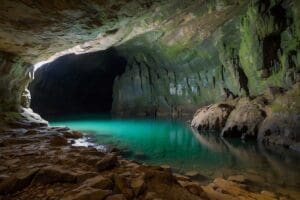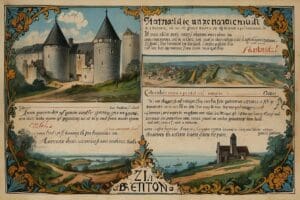The Royal Palaces of Europe: A Grand Tour from Versailles to Buckingham
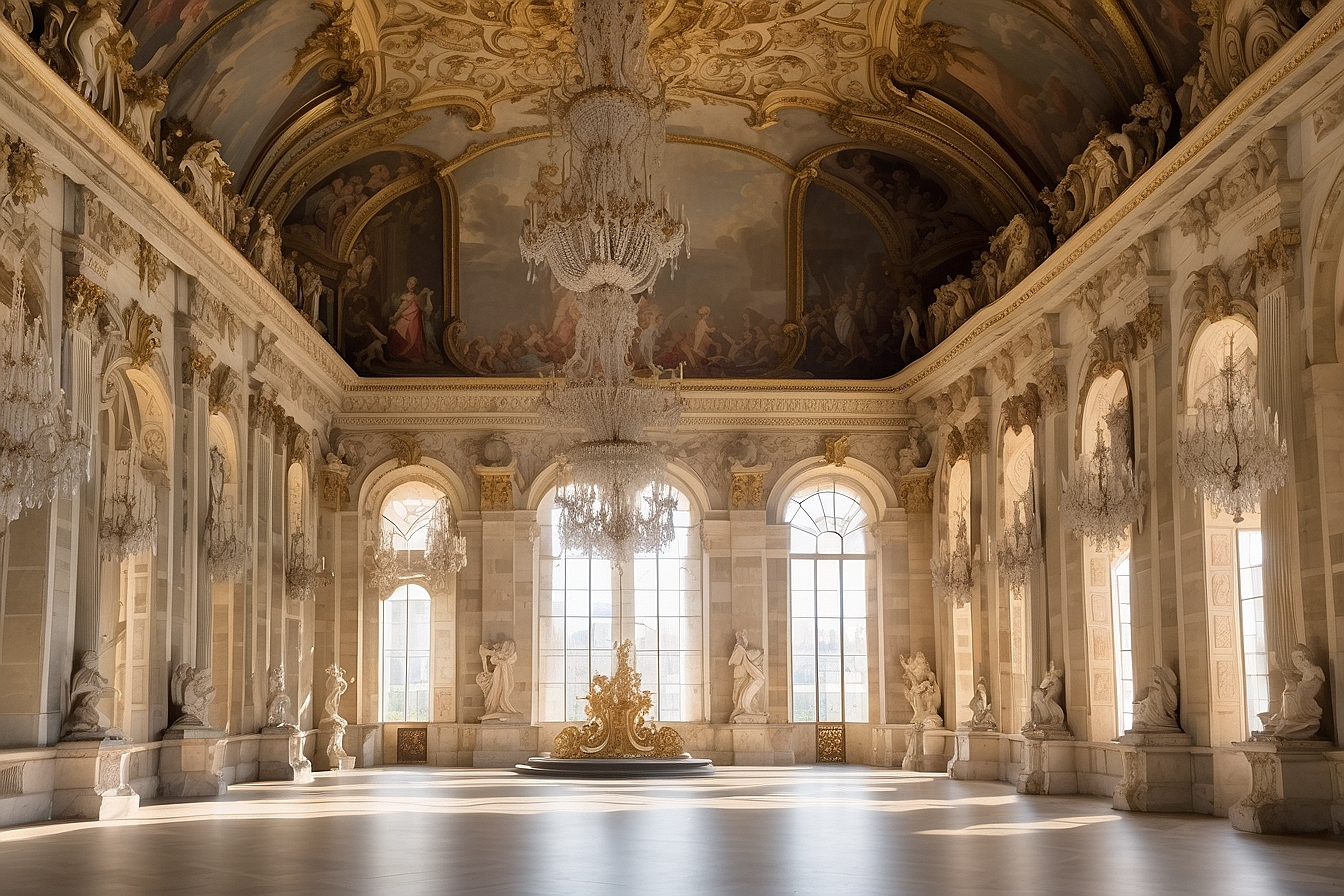
Updated On: March 13, 2024 by Noha Basiouny
The royal palaces of Europe are beacons of history and monuments to the architectural grandeur of the past. These grand estates tell the stories of monarchs, revolutions, and the evolution of nations, each palace with its unique narrative etched into lavish hallways and opulent chambers. From the sweeping gardens of the Palace of Versailles, a symbol of absolute monarchy in France, to the official London residence of the British sovereign, Buckingham Palace, these structures have transcended their original purposes to become icons of cultural heritage.
While exploring these palaces, one not only walks through the corridors of power but also witnesses the intersection of art and architecture that has profoundly shaped Europe’s identity. Each grand facade and decorative interior serves as testament to the continent’s rich artistic heritage, immortalising the artistic movements that have defined different eras. From the Baroque splendour to the Gothic intricacies, palaces across the United Kingdom, France, Austria, Spain, Germany, and beyond exhibit a mosaic of styles that continue to mesmerise visitors.
Table of Contents
Historical Context and Significance
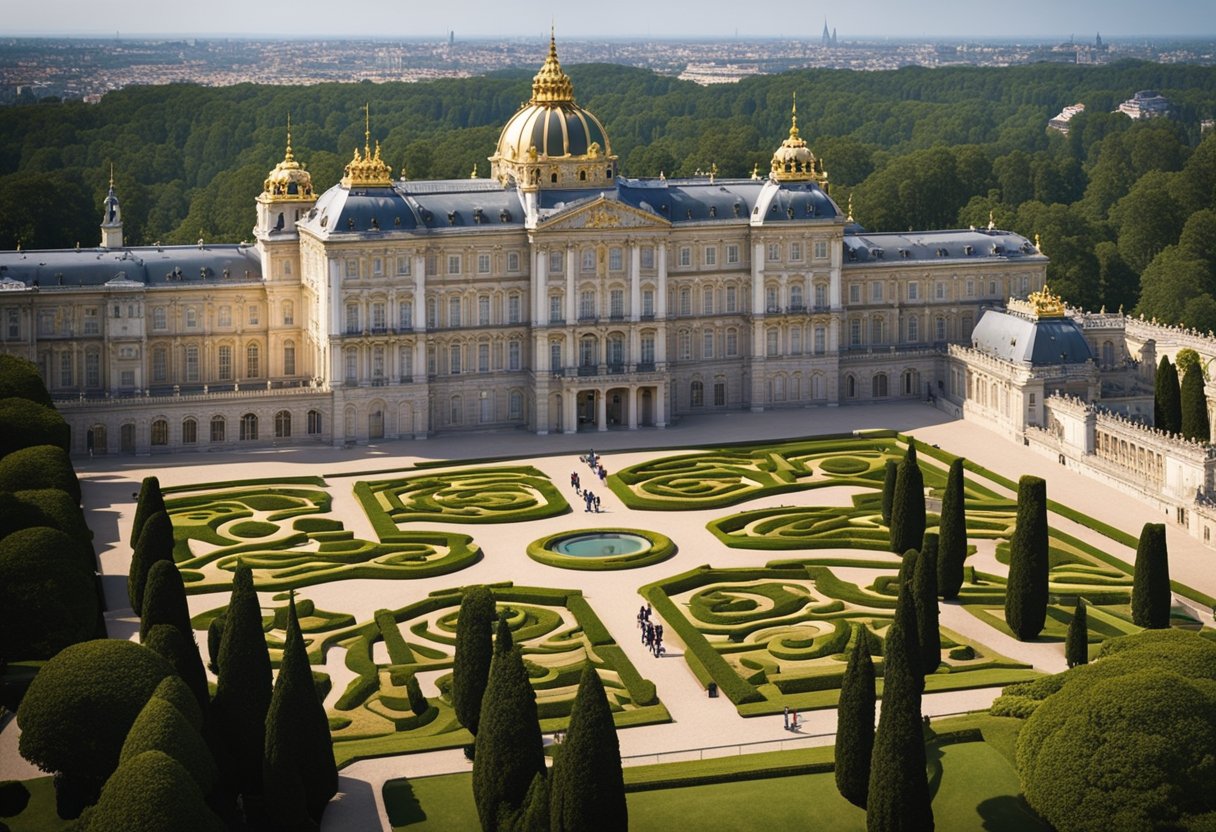
Our exploration of Europe’s royal palaces cannot commence without acknowledging their profound historical significance. Palaces like Versailles in France are symbols of monarchical power and architectural grandeur. Built initially as a hunting lodge in 1624, the Palace of Versailles developed into a monumental complex under King Louis XIV, reflecting the absolute power of the French monarchy.
In the UK, Buckingham Palace has served not only as a residence for the royal family but also as a focal point for national celebration and mourning. These edifices, such as the imposing Neuschwanstein Castle in Germany and the Winter Palace in Russia, transcend their role as mere structures to become emblematic of historical epochs and governmental shifts, particularly around events like World War I, which saw the end of several European monarchies.
Furthermore, many of these palatial structures are recognised as UNESCO World Heritage Sites, reinforcing their global significance. For instance, Schönbrunn Palace in Austria and the expansive Alhambra in Spain are not just historical markers but pieces of a legacy that spans centuries of European history, culture, and politics.
It is our privilege to unravel the stories woven into the fabric of these grand constructions, each a repository of a bygone era, each a castle or palace that tells of the country’s heritage. We find ourselves, custodians of past narratives, as these sites continue to be pivotal in understanding our collective past, and in some ways, they shape our approach to the present and the future.
Architecture and Artistic Heritage
Europe’s royal palaces, much like their names suggest, are a display of artistic wealth and architectural prowess. We invite you to discover the grandeur of Baroque symmetry, Gothic romanticism, and Rococo’s light-hearted beauty, as seen in three of Europe’s most famous palaces.
Baroque Majesty
The Palace of Versailles, with its grand geometric lawns and ornate interiors, is a testament to Baroque architecture. Synonymous with magnificence, the palace’s Hall of Mirrors, with its intricately painted ceilings, is complemented by an expansive art collection, reflecting the opulence of French royalty. The Royal Palace of Caserta, modelled on Versailles, similarly boasts a majestic Baroque façade and is adorned with lavish decorations that echo the grand lifestyle of the European elite.
Gothic Fairy Tale
The Gothic era breathed a different kind of charm into the royal abodes. Unlike the Baroque’s boldness, Gothic designs in places like The Royal Palace give us fairytale-like spires that reach for the sky and pointy arch windows that let in a mystic light, weaving a story of medieval romance and legend.
Rococo Elegance
Finally, the Rococo brings forth an air of playful sophistication. The Schönbrunn Palace, with its elaborately painted ceilings, exemplifies Rococo elegance. This light and airy style is about pastel colours, decorative arts, and charmingly asymmetric patterns, creating a sense of whimsy that dances through the halls of European royalty.
Each style holds a narrative of Europe’s past, expressing the tastes and philosophies of the time. We have just scratched the surface of these stories written in stone and colour, a heritage preserved in the architecture and art of these storied walls.
The Royal Palaces of the United Kingdom
The United Kingdom’s royal palaces are steeped in history and grandeur, each telling its own story of the monarchy. Buckingham Palace stands as the quintessential seat of the British Monarchy, while Windsor Castle serves as a private royal residence and a venue for royal weddings.
Buckingham Palace and the British Monarchy
Buckingham Palace is perhaps the most iconic royal residence in our collective consciousness. Known as the primary London residence of the British sovereign, the palace has served as the administrative headquarters of the monarchy since the accession of Queen Victoria in 1837. The stately Changing of the Guard ceremony, symbolic of the palace and the constitutional monarchy itself, is a major draw for visitors worldwide. The palace’s grandeur has also been a backdrop to numerous royal weddings, exemplifying its role in the national culture and heritage.
Buckingham Palace features 775 rooms, and the palace’s stunning garden, with over 350 types of wildflowers alone, certainly merits its reputation. Through its nearly 200 years as a royal residence, it remains a symbol of the state and the setting of official events and receptions held by the Queen.
Windsor Castle: A Royal Residence
Moving beyond the city and into the town of Windsor, Windsor Castle represents over 900 years of British history. It is the longest-occupied palace in Europe, with monarchs residing there since Henry I’s reign. Today, Windsor Castle is often used for state banquets and official entertaining, remaining a working palace.
The significance of Windsor Castle extends to its role in the personal lives of the royals; it has been the site of recent royal nuptials, echoing its enduring association with the British Monarchy. As a fortress, it has stood the test of time, playing a central part in the United Kingdom’s heritage.
These palaces encapsulate the essence of the UK’s constitutional monarchy, blending centuries of tradition with the obligations of modern royalty. They are not only homes for the royal family but also monuments open to the public, allowing us to engage with the tangible history of our reigning monarchy.
France’s Majestic Palaces
In France, palaces are not just residences; they are grand symbols of power and artistry. The famous Palace of Versailles and the châteaux scattered along the Loire Valley each tell a story of opulence, political power, and cultural significance that reverberates well beyond their splendid walls.
Versailles: A Symbol of the Sun King
The Palace of Versailles is an enduring emblem of Louis XIV’s reign, known as the Sun King. This palace is the epitome of French grandeur during the 17th century, with the Hall of Mirrors as its crowning jewel. The gallery’s 357 mirrors symbolised the power of the Sun King and was where the Treaty of Versailles was signed to end World War I. The Palace’s enchanting gardens and the Trianon palaces further showcase the luxuries of the French monarchy before the French Revolution brought about its fall.
Châteaux of the Loire Valley
The Loire Valley, celebrated for its splendid châteaux, offers a remarkable journey through France’s Renaissance and Enlightenment periods. Each château reveals unique architectural and historical treasures – from Chambord with its distinct French defensive architecture to Chenonceau spanning the River Cher, renowned for its stunning beauty and gardens. The region’s importance and influence were recognised when the Loire Valley was inscribed on the UNESCO World Heritage List. These châteaux are not just stone and mortar; they narrate the tales of the French nobility and their opulent lifestyles.
Imperial Residences of Austria
Austria, with its rich imperial history, is replete with majestic residences that once housed the Habsburg dynasty. Vienna, the capital city, is notably home to these grandiose structures, each telling a story of the country’s regal past.
The Hofburg: A Habsburg Seat of Power
The Hofburg Palace, nestled in the heart of Vienna, stands as a testament to the grandeur of the Habsburg Empire. As a former seat of power, it’s a complex of various architectural styles, reflecting the expansions made over centuries. Stepping into the Great Gallery, visitors are enveloped in an atmosphere of imperial opulence with its elaborate frescoes and intricate decorations.
- Location: Vienna
- Significance: Former imperial palace
- Key Features:
- Great Gallery
- Habsburg artefacts
- Architectural diversity
Schönbrunn: Imperial Summer Retreat
Schönbrunn Palace served as the summer residence of the Habsburgs and is one of Vienna’s most visited sites. This majestic palace, with its 1,441 rooms, epitomises the tastes and ambitions of the imperial era. The beautifully preserved Imperial Summer Residence, set amidst sprawling gardens, allows visitors to walk the same halls as the Habsburgs and to imagine the lavish lifestyle they led.
- Location: Vienna
- Significance: UNESCO World Heritage Site
- Key Features:
- Schönbrunn Palace
- Baroque architecture
- Imperial history
Both these historic sites continue to be pivotal in showcasing Austria’s imperial heritage and are open to the public, inviting us to explore their grandeur and historical significance.
Royal Sites of Spain
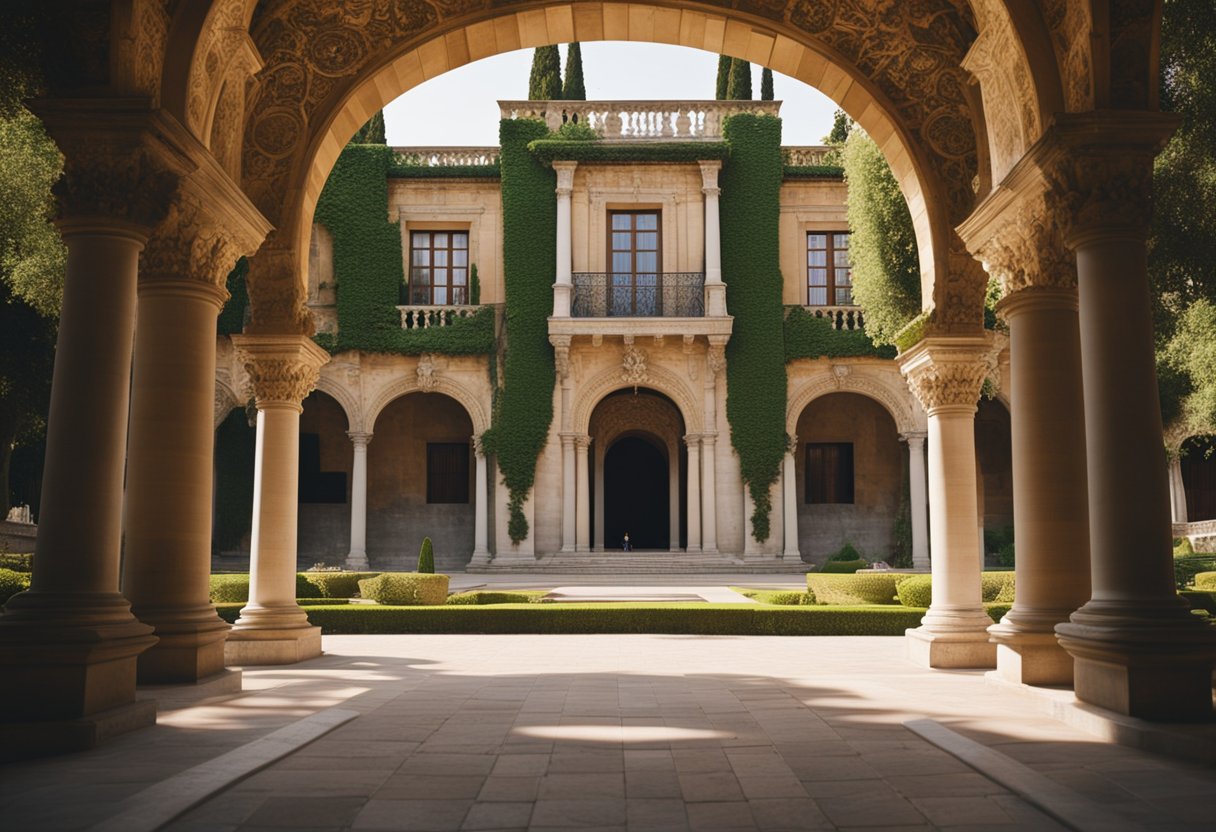
Spain’s majestic past breathes through its royal palaces, which remain a testament to the nation’s rich history and the splendour of its regal traditions.
Madrid’s Palatial Centrepiece
The Royal Palace of Madrid stands as a proud emblem of the Spanish monarchy’s heritage. Encompassing an expansive 1,453,122 sq ft, this grandiose structure houses a staggering 3,000 rooms. Noted for its sizeable floor space, it eclipses other European royal residences in magnitude. The palace is not merely an architectural marvel but also contains the esteemed Royal Collection, boasting valuable art, tapestries, and armoury. The Royal Palace is a living piece of history and a working residence for the Spanish Royal Family, affirming Madrid not only as Spain’s capital but also as the heart of its monarchy.
The Neapolitan Connection
The Royal Palace of Madrid and the monumental Royal Palace of Caserta near Naples share a distinctive architectural lineage. Commissioned by the Bourbon Kings who ruled over both Spain and the Kingdom of Naples, these palatial estates exhibit comparable grandeur and design sensibilities. Although separated by geography, the influence of the Neapolitan and Spanish courts reflects a harmonious blend of culture, royalty, and ambition, underscoring the significant impact of the Spanish monarchy beyond its own borders.
Palatial Tales of Germany
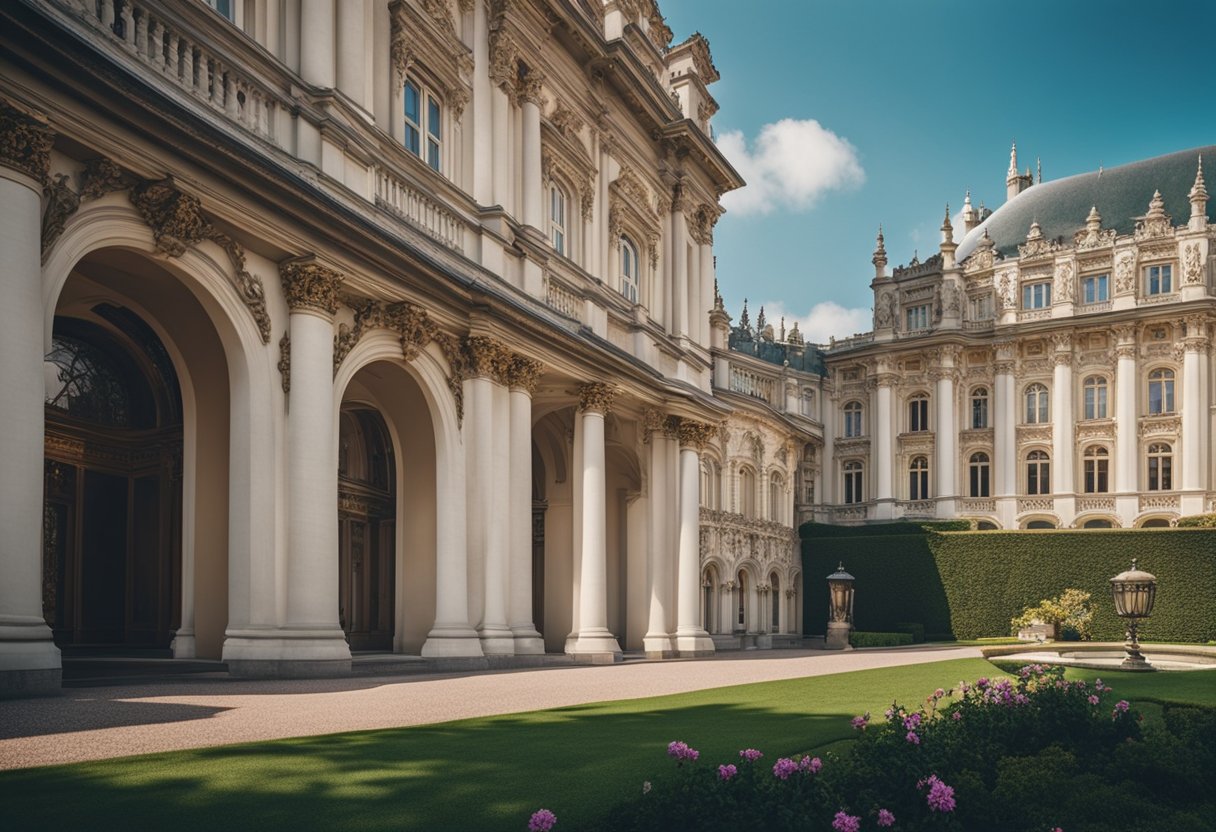
Germany is adorned with remarkable royal structures that echo the country’s rich history. Among them, two stand out for their architectural splendour and historical significance: the fairytale Neuschwanstein Castle and the Rococo beauty Amalienburg.
Neuschwanstein: Ludwig’s Fantasy
Perched atop the rugged terrain of Bavaria, Neuschwanstein Castle is the embodiment of King Ludwig II’s romantic vision. Inspired by the operas of Richard Wagner, this majestic castle was intended as a personal retreat for the reclusive king. With its towering white turrets and scenic backdrop, Neuschwanstein encapsulates the king’s longing for a mythical world of knights and epic tales. Travellers to this Bavarian masterpiece are often struck by its dramatic setting and opulent interiors.
Amalienburg: Rococo Jewel
In stark contrast to Neuschwanstein’s grandiosity, the Amalienburg stands as a delicate Rococo palace nestled within the Nymphenburg Palace Park in Munich. Designed by François de Cuvilliés, the Amalienburg was constructed as a hunting lodge and retreat for Electress Maria Amalia. Its intricate design and the Hall of Mirrors are particularly renowned, showcasing an intimate and ornate interior where light plays off the mirrored surfaces and elaborate frescoes – a true Rococo jewel.
Scandinavian Royal Dwellings
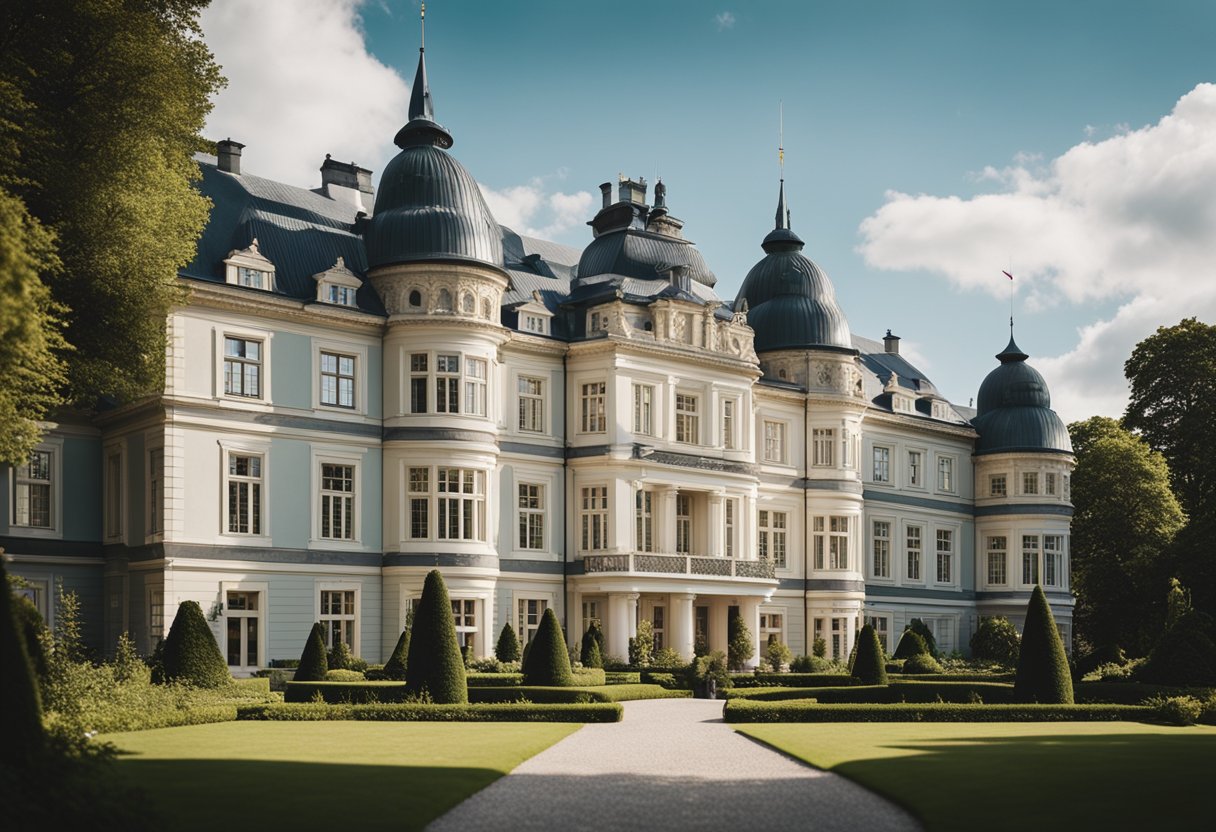
Scandinavia, with its rich history and cultural heritage, is home to some of the most magnificent and historically significant royal palaces in Europe. Each residence encapsulates the unique royal traditions of the region.
Stockholm’s Drottningholm
Drottningholm Palace, the private residence of the Swedish royal family, stands with grace on the island of Lovön. As a UNESCO World Heritage Site, it is one of Sweden’s most treasured national symbols. The palace grounds boast an exquisite Baroque garden that is transformational for its time and continues to draw visitors from all corners of the globe. This stellar example of a royal residence has inspired European architecture for centuries, and its history is woven into the cultural fabric of Stockholm.
Denmark’s Frederiksborg
Crossing into Denmark, Frederiksborg Castle paints an equally impressive picture with its Renaissance architecture. Situated in Hillerød, north of Copenhagen, the castle reflects Denmark’s profound royal lineage. The exquisite Chapel of Orders, boasting a star-studded vault and intricately carved pews, tells a tale of ceremony and regality. The surrounding National Parks provide a natural embrace, creating a serene juxtaposition between regal opulence and Denmark’s untamed beauty.
Eastern European Monarchical Residences
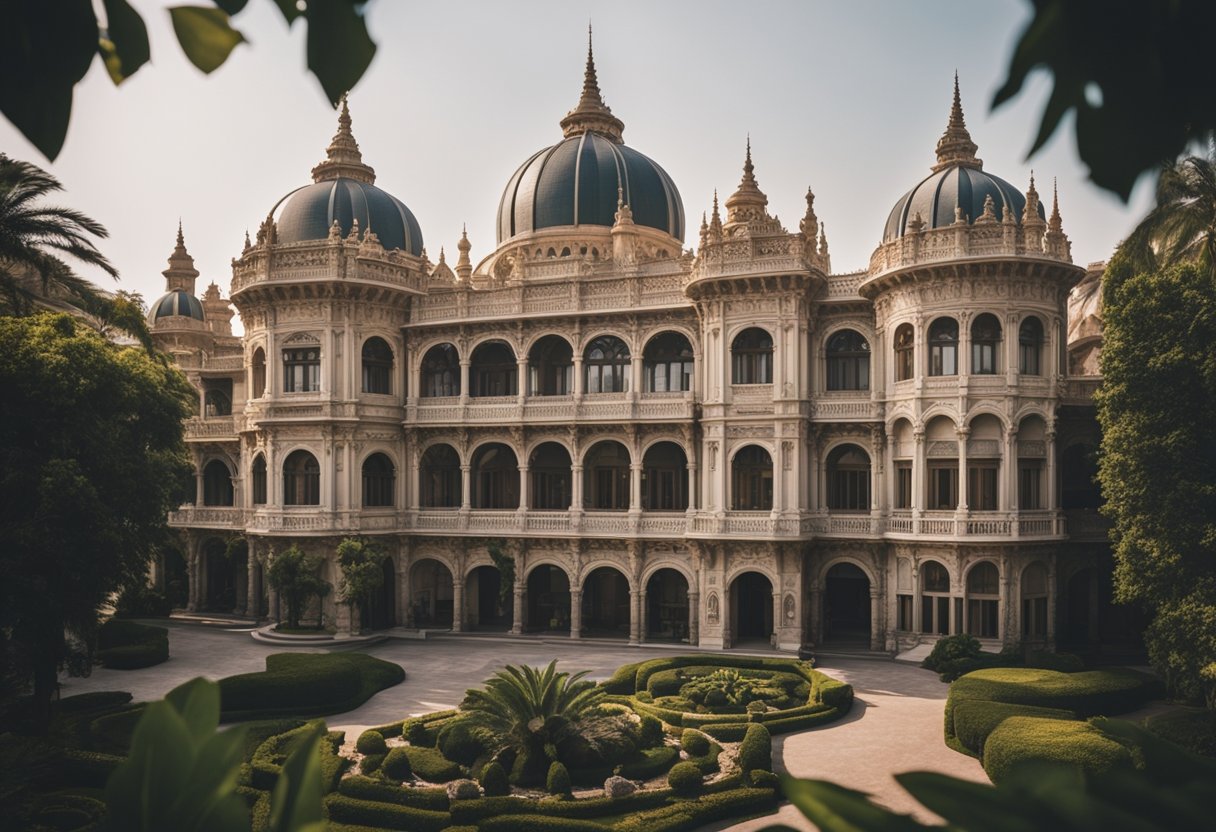
The palaces of Eastern Europe tell a tale of opulence and geopolitical power, incarnate in the icy grandeur of Russia’s Winter Palace and the ornate splendour of the Ottoman Empire’s regal homes.
Russia’s Wintery Majesty
In St. Petersburg, the Winter Palace stands as a symbol of Russia’s imperial past. Erected during the reign of Catherine the Great, this architectural masterpiece was the official residence of the Russian monarchs. It embodies Russia’s magnificence with its vast scale and the Baroque style that dominates its façade and interiors.
Ottoman Imperial Splendour
In contrast, the Ottoman Empire’s presence in Turkey is marked by palaces that echo the legacy of Sultans who once ruled. The palaces are exquisite examples of Ottoman architecture, with intricate designs and lush gardens that encapsulated their imperial power and wealth.
Preservation and Public Access
As custodians of history and culture, we are dedicated to preserving the splendour of Europe’s royal palaces and ensuring they can be accessed by the public. Through meticulous conservation efforts and the embrace of digital technologies, these historic sites continue to offer immersive experiences that both educate and inspire.
Adapting to Modern Times
We understand the importance of adapting to modern times to keep these historic attractions relevant and accessible. For instance, log-in and log-out features on official websites allow for personalised experiences, while online ticket purchasing makes access more convenient for visitors worldwide. The implementation of advanced reservation systems and virtual tours has become a necessity, especially in light of global events that may limit physical visitation. The Royal Collection Trust also facilitates online engagement, offering insights into the collections housed within these palatial walls.
Museum Exhibitions and Tours
Museum exhibitions within royal palaces like Versailles often serve to highlight their UNESCO World Heritage status, shining a light on the unique qualities that make them universally significant. Curated tours, both in-person and virtual, offer a glimpse into the opulence of royal life. These tours are often augmented by audio guides and interactive displays that enrich the visitor experience. By purchasing tickets to these exhibitions or engaging with a guided tour, visitors contribute to the ongoing preservation of these magnificent sites. It’s through these avenues that we invite people to step into the past and walk amongst the grandeur of Europe’s royal history.
Current Use and Ceremonial Functions of the Royal Palaces of Europe
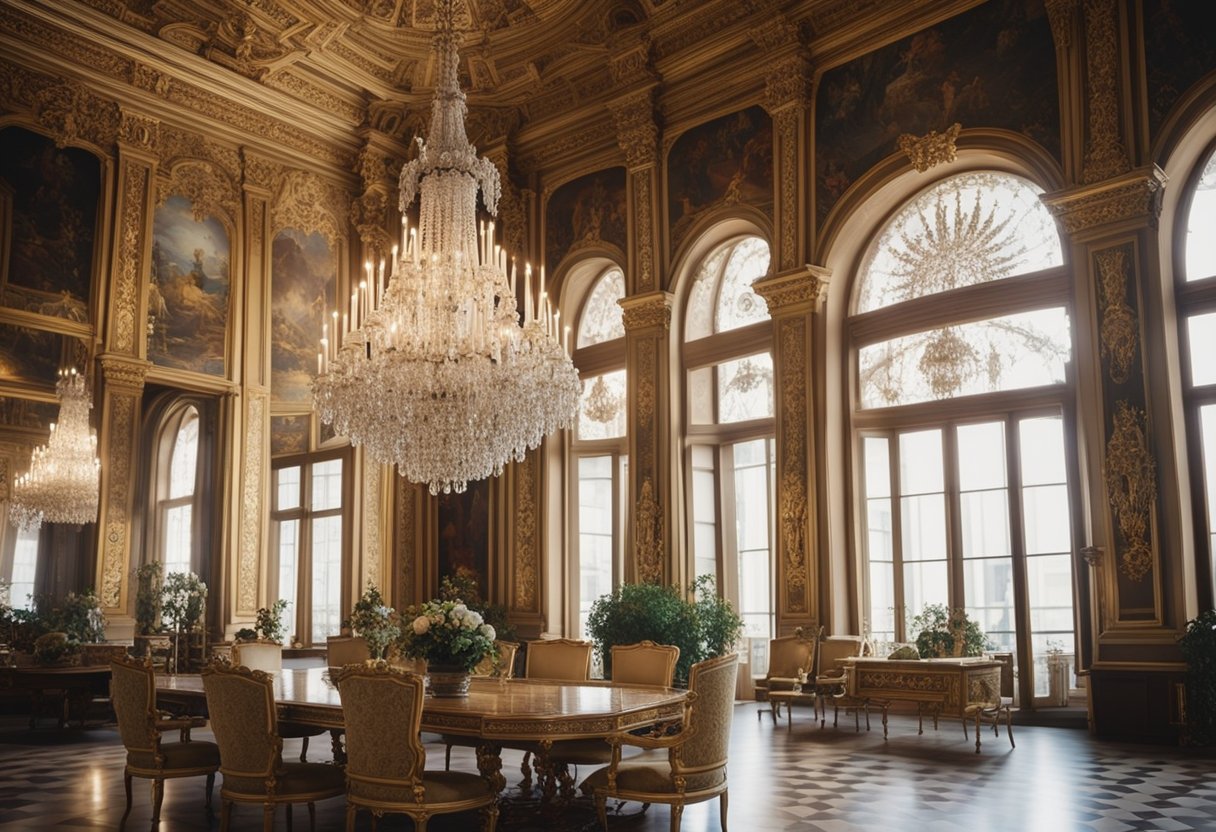
Royal palaces across Europe serve as much more than historical monuments. We find that many, such as the Palace of Versailles, have transformed from regal residencies to spaces for diplomatic meetings and cultural engagements. Notably, the magnificent State Rooms of these palaces are often used for hosting foreign dignitaries.
In the context of a constitutional monarchy, these buildings support the functioning of the state. Buckingham Palace, for instance, houses not only offices but also serves as the primary residence for the monarchy, hosting various ceremonial duties and celebrations. These residences retain their importance in national ceremonies. For example, the iconic Changing of the Guard ceremony at Buckingham Palace is a significant tourist attraction and a display of the country’s military heritage and discipline.
Castles, once medieval strongholds, now play host to ceremonial events while being open to the public, allowing people to witness the grandeur of royal living spaces, including the opulent bathrooms and meticulously preserved offices.
It’s worth noticing that not all spaces within the palaces are open for public viewing. Certain areas remain highly functional, fulfilling the demands of modern governance and the personal lives of the royal families. Nevertheless, these historic sites continue to weave the past with the present, highlighting a rich tapestry of Europe’s heritage.
Frequently Asked Questions
When exploring the majestic royal palaces of Europe, from the sprawling gardens of Versailles to the historic rooms of Buckingham Palace, a plethora of questions arise. We’ll tackle some of the most frequently asked ones to enhance your understanding of these regal residences.
Which European palace is the most expansive in size?
The Palace of Versailles in France, with its vast gardens, stretches over an area of 87,728,720 square feet, making it one of the largest palace complexes in Europe.
What are the main architectural influences of the Palace of Versailles on other European palaces?
The Palace of Versailles has significantly influenced other European palaces with its French Baroque architecture, characterised by elaborate ornamentation, classical statues, and large formal gardens.
Is the Palace of Versailles larger than Buckingham Palace?
Yes, the Palace of Versailles is larger than Buckingham Palace. Versailles boasts a considerable size, including extensive gardens, while Buckingham Palace is a large urban residence with 775 rooms.
Which residence served as the royal palace before Buckingham Palace?
Before Buckingham Palace, St. James’s Palace was the primary residence of English monarchs in London. It still retains its status as the ceremonial meeting place for the Accession Council that proclaims a new sovereign.
Which palace is considered the most remarkable in terms of grandeur and beauty in Europe?
Many would argue that the Palace of Versailles is Europe’s most remarkable palace in terms of grandeur and beauty, celebrated for its opulent decoration, Hall of Mirrors, and expansive gardens.
How does the Royal Palace of Caserta compare to other famous European palaces in scale and design?
The Royal Palace of Caserta, with its impressive baroque and neoclassic architecture, rivals Versailles in terms of scale and design, featuring vast grounds, an intricate aqueduct system, and luxurious interiors.



